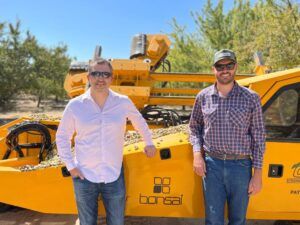Editor’s Note: Emily Byrd is the communications manager for The Good Food Institute, a nonprofit that works with scientists, investors, and entrepreneurs to support innovations in plant-based foods and clean meat. Here she outlines some of the key biotechnologies needed to produce animal slaughter-free meat through cellular agriculture.
Growing meat through cellular agriculture, or what we are now calling “clean meat” production, is the process of growing a small cell sample into a full piece of animal meat, outside of an animal, circumventing much of the pollution and inefficiency of factory farming.
In 2013, Professor Mark Post of Maastricht University proved this could be done when he debuted the first clean meat hamburger in London.
At the time, the novel $330,000 innovation caught the attention of visionaries and researchers. Since then, there have been meaningful advances in clean meat production, and three of the most prominent clean meat companies — Dr. Post’s Mosa Meats, the Bay Area startup Memphis Meats, and New York-based SuperMeat — plan to have products on the market within five years and be price-competitive with conventional meat in 10 years.
Now, both future-facing venture capitalists and the most traditional global food companies are looking closely at investments in this promising technology. Even Tyson Foods, one of the largest conventional meat producers in the world, recently made waves when it announced the launch of its $150 million venture fund focused on sustainable innovation and said it was considering clean meat as a potential investment area.
“Clean meat will overtake conventional production methods, because it’s simply a better product from the ground up,” says Chris Kerr, managing partner of New Crop Capital, the first venture capital fund specifically focused on investing in plant-based and clean meat. “At scale, it’s going to be much more efficient than conventional animal agriculture. When we make meat today, we also grow tails and eyeballs and hair – and an enormous amount of manure – when all we want is a little bit of meat. Clean meat will fundamentally disrupt the meat market and the inefficient infrastructure that goes along with it. If you’re interested in investing in the future of protein, it doesn’t get much more exciting than that.”
To put that in context: turkey stem cells have already been shown to divide more than 100 times without losing their ability to mature into muscle. This means that using clean meat technology, more than 40 times the current global demand for turkey could be met from just a single turkey biopsy about the size of a sesame seed. Think about that.
Despite the promise of this nascent field, much more investment in needed. Understanding the exact challenges and R&D opportunities for clean meat also requires a bit of insider information.
To get just that, two senior scientists from The Good Food Institute, mechanical engineer Christie Lagally and bioengineering specialist Dr. Liz Specht, have broken down the four critical technologies required to get clean meat to market, and what it will take to get it there.
1. Cell Lines
Cell lines contain the different types of cells–muscle, fat, and more–that then proliferate in cell culture to create slaughter-free meat. Thanks to decades of research in the biomedical community, the technology for producing these cell lines is already well advanced. However, until now there has never been a reason for scientists to formulate cell lines that are relevant for clean meat production.
As clean meat becomes the focus of more capital investment, that motivation is becoming evident.
2. Cell Culture Media
Media is the nutrient mixture that allows cell lines to grow and replicate. Currently, most clean meat production relies on animal-based serum, which is problematic not only because this type of serum is a by-product of factory farming, but also because it is notoriously inconsistent from batch to batch.
“To put it succinctly, once clean meat is commercialized, no animal products will be used in media, for both ethical and practical reasons,” Dr. Specht explains. “Fortunately, hundreds of animal-free media formulations have been developed for use in research and human medicine. Now what’s needed is the funding and impetus to optimize these formulas for producing clean meat.”
Further innovation is needed to develop lower-cost formulations and media recycling capabilities in order for clean meat to reach price parity with conventional meat—because while no one will haggle over the cost of their replacement knee cartilage, a hamburger can’t cost as much as a medical procedure.
3. Scaffolding
Once relevant cell lines are available and given animal-free media to encourage growth, scaffolding is required to direct cells to grow in the ideal ratio and shape. This is important to ensure that the final product tastes and looks like the conventionally-produced meat people are used to.
Mark Post’s first hamburger and Memphis Meat’s first meatball were comprised entirely of muscle cells, but a realistic clean meat product has to contain muscle, fat, connective tissue – all of the bite-to-bite variation that appeals to consumers.
Several materials that are already used in food products are being explored as edible clean meat scaffolds, and the Bay-area startup Geltor is looking at the possibility of creating scaffolding using animal-free collagen.
4. Bioreactors
At scale, clean meat will be “brewed” in large fermenters, much like you would find in a Budweiser (or Dogfish Head) factory. Right now, the bioreactors available for clean meat production are nowhere near the size needed to meaningfully disrupt the food system.
Luckily, clean meat pioneers have proposed several options for the large-scale production of clean meat, including stirred tank reactors, perfusion reactors, and packed-bed reactors (which, going back to the brewery analogy, is conveniently abbreviated as “PBR”). Most likely, the production pipeline will actually entail different types of bioreactors for different stages of the process – one for growing the cells, and another for coaxing them into fat and muscle on a scaffold. Developing and testing this equipment simply requires (you guessed it) additional funding and a coordinated engineering effort.
“To get clean meat to market in five years, it’s going to take a concerted effort from researchers and significant investment support,” GFI’s Lagally explains. “Clean meat requires a multidisciplinary collaboration, but there is every reason for investors and entrepreneurs to bring this product to the commercial market, and we expect them to take hold of this monumental opportunity.”
With funding to grease the wheels of innovation, market leaders like Mosa Meats, SuperMeat, and Memphis Meats will answer the biggest question in food tech: How do we feed 9.7 billion people by 2050 without inducing a climate meltdown?
For investors interested in doing well while doing the most good, clean meat represents an incredibly compelling opportunity.




